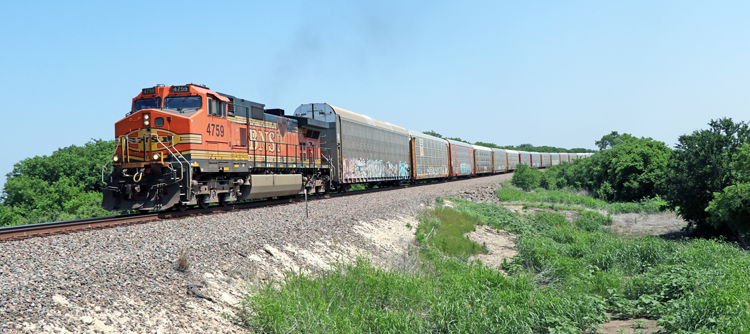All about the community of model railroading and rail enthusiasm
January 2, 2024 / Updated January 11, 2024
UPDATED Jan. 11, 2024 – December brought needed relief to the U.S. railroad industry with the reopening of two key international border crossings and a surge in combined rail traffic to fuel a fourth-quarter rally.
U.S. Customs and Border Protection (CBP) announced just before Christmas the reopening of crossings at Eagle Pass and El Paso, TX. The crossings were temporarily closed for five days in an effort to help CBP officers assist Border Patrol agents with the influx of illegal border crossings.

“The Biden Administration made the right decision to protect our supply chain and keep goods moving between the U.S. and Mexico,” said Association of American Railroads president and CEO Ian Jefferies. “In the face of the unprecedented humanitarian crisis, CBP has been working under exceptionally difficult circumstances, but these ill-advised closures were a blunt force tool that did nothing to bolster law enforcement capacity. As CBP continues their work to address this crisis, railroads strongly encourage the agency to abandon this tactic moving forward in favor of approaches that are capable of meaningfully enhancing its response capabilities.”
AAR immediately called for the crossings to reopen when they were shuttered, saying their closures unleased a cascade of delays across operations on both side of the border. Each day, BNSF and Union Pacific operate 24 trains across the crossings, moving agricultural products, automotive parts, finished vehicles, chemicals, consumer goods and more to customers on both sides of the border, AAR said. Roughly 450,000 rail shipments move across the gateways annually.
UP estimated more than $200 million in goods, wages and transportation costs were lost each day the crossings were closed.
According to Bureau of Transportation Statistics, El Paso and Eagle Pass accounted for $33.95 billion or 35.8 percent of all cross-border rail traffic from November 2022-October 2023. During that same period, about 7.04 million metric tons of product moved via rail to/from Mexico through the crossings.
“With the crossings reopened, railroads are focused on closely partnering with CBP to maintain the secure, reliable service that customers deserve and our nation requires,” Jefferies said.
Elsewhere across the U.S., rail traffic flowed at a sound rate in December, completing a streak of eight consecutive weeks of greater combined carload and intermodal traffic over the same weeks in 2022. Combined U.S. carload and intermodal originations for the month were 1,859,264, up 8.8 percent, or 150,685 carloads and intermodal units from December 2022.
U.S. railroads originated 876,881 carloads in December 2023, up 7.3 percent, or 59,804 carloads, from December 2022. U.S. railroads also originated 982,383 containers and trailers, up 10.2 percent, or 90,881 units, from the same month last year.
Rail traffic was up in each of the three previous weeks of December, including 502,583 carloads and intermodal units (up 7.6 percent) the week ending Dec. 16.
Sixteen of the 20 carload commodity categories tracked by the AAR each month saw carload gains compared with December 2022. These included: chemicals, up 14,636 carloads or 13.1 percent; coal, up 13,971 carloads or 5.9 percent; and motor vehicles & parts, up 7,212 carloads or 14.1 percent. Commodities that declined year over year included: crushed stone, sand and gravel, down 2,781 carloads or 4.1 percent; nonmetallic minerals, down 1,105 carloads or 9.8 percent; and all other carloads, down 625 carloads or 3.3 percent.
“Total U.S. rail carloads were up two percent in the fourth quarter of 2023 over the fourth quarter of 2022, while U.S. intermodal was up 5.5 percent over the same period. That means Q4 was clearly the best quarter of 2023 for U.S. rail volumes on a year-over-year basis,” said AAR Senior Vice President John T. Gray. “It appears that intense rail efforts to improve service quality are paying off. Railroads are hopeful that gains in the fourth quarter will carry over into the first quarter of 2024 and beyond.”
The surge cut a 3.3 percent deficit in combined U.S. rail traffic for the year by a full percent. Rail traffic finished at 24,369,229 carloads and intermodal units.
Combined U.S. carload and intermodal originations in October and November were up one percent and 2.6 percent, respectively.
For the week ending Dec. 23, all of the 10 carload commodity groups posted an increase compared with the same week in 2022. They included coal, up 16,458 carloads, to 66,730; motor vehicles and parts, up 4,936 carloads, to 16,287; and grain, up 4,475 carloads, to 21,237.
For the year, motor vehicles and parts (up 12.7 percent) and petroleum and petroleum products (up 11 percent) have led gains.